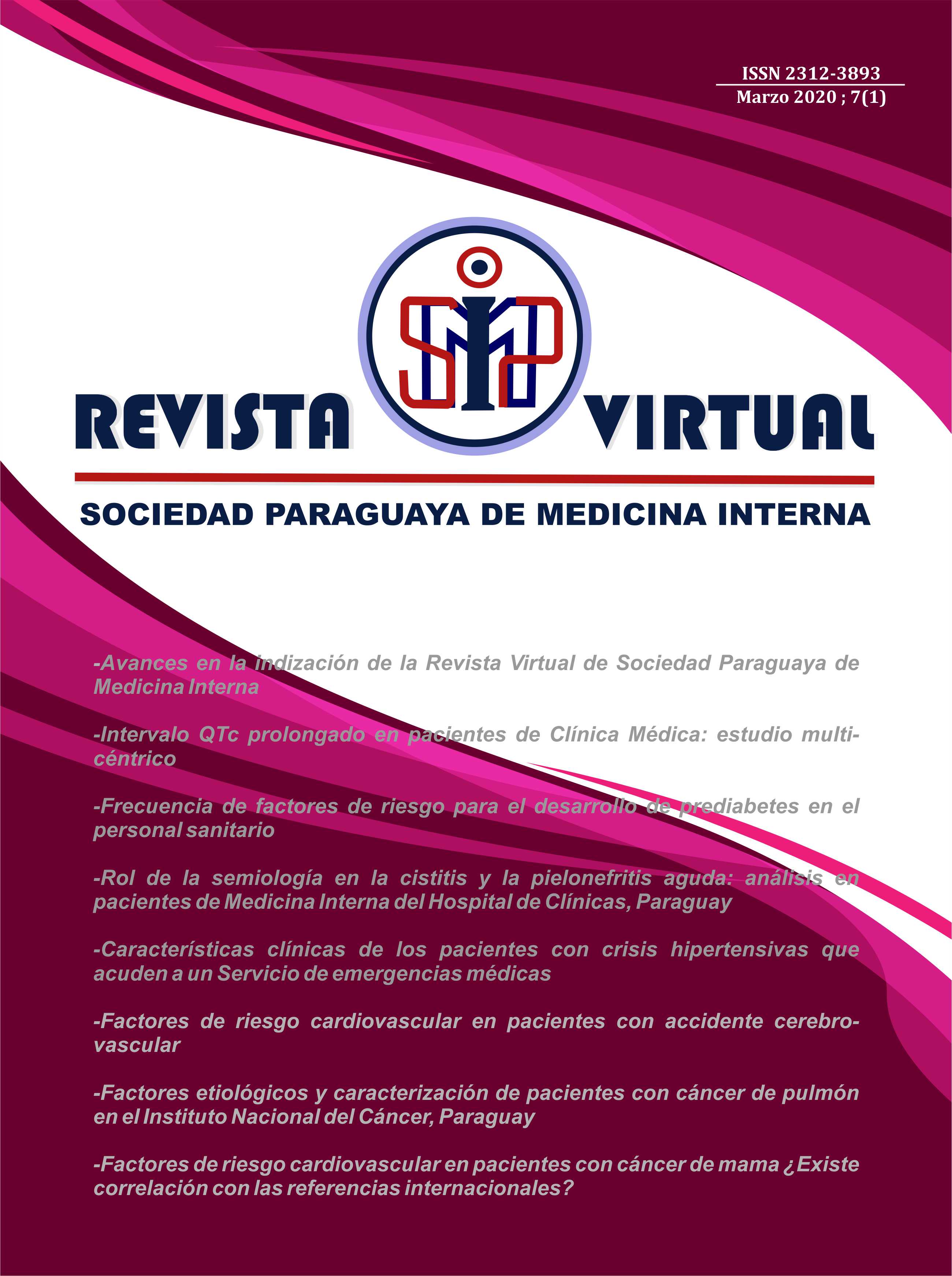Uso de estatinas en adultos mayores de 80 años
Resumen
Introducción: La enfermedad cardiovascular (ECV) es la principal causa de muerte en todo el mundo, el riesgo aumenta con la edad, con tasas de incidencia y mortalidad casi tres veces mayores en los adultos mayores. Las estatinas han demostrado la eficacia en la reducción de la mortalidad por ECV, aunque puede tener efectos adversos. Su uso en adultos mayores, tanto en prevención primaria como secundaria, sigue en controversia.
Objetivo: revisar el estado actual, eficacia y seguridad, efectos colaterales, guías actuales y perspectivas futuras sobre el uso de las estatinas en adultos de 80 años o más.
Material y método: Revisión de la literatura de los últimos cinco años en MEDLINE, SCOPUS, LILACS y COCHRANE, utilizando las palabras clave: estatinas y anciano.
Resultados: La prevalencia del uso de estatinas en adultos ≥ 80 años varió entre 17 y 39% en residentes de hogares de ancianos, 12 y 59% para pacientes que viven en la comunidad y de 18 a 45% en poblaciones combinadas. Las indicaciones pueden ser para prevención primaria o secundaria. La eficacia del tratamiento con estatinas para prevención secundaria, en los ancianos es bien documentada con evidencia fuerte, pero las evidencias son escasas y débiles para prevención primaria. Los efectos adversos, más frecuentes, están asociados a trastornos musculoesqueléticos. En los últimos cinco años, se han publicado siete directrices importantes sobre las estatinas. En la guía 2018 AHA/ACC sobre el manejo de colesterol y en la guía 2019 ACC/AHA sobre prevención primaria de ECV, la prescripción de estatinas en ancianos se mantuvo sin cambios.
Conclusión: el uso de la estatinas en la prevención secundaria está claro, y los beneficios son mayores que los eventuales efectos adversos, los que pueden incrementarse en los adultos mayores, en el contexto de polifarmacia por las interacciones farmacológicas y las principales comorbilidades que son más comunes en las personas mayores, en particular en aquellos pacientes con uso prolongado y a dosis alta de estatinas.
Citas
Ramos R, Comas-Cufí M, Martí-Lluch R, Balló E, Ponjoan A, Alves-Cabratosa L, et al. Statins for primary prevention of cardiovascular events and mortality in old and very old adults with and without type 2 diabetes: retrospective cohort study. BMJ. 2018; 362:k3359.
Mortensen MB, Falk E. Primary prevention with statins in the elderly. J Am Coll Cardiol. 2018; 71(1):85-94.
Ortellado Maidana J, Ramírez A, González G, Olmedo Filizzola G, Ayala de Doll M, Sano M, et al. Consenso paraguayo de hipertensión arterial 2015. Rev. virtual Soc. Parag. Med. Int. 2016; 3(2):11-57.
Venegas Sanabria LC, Barbosa Balaquera S, Suarez Acosta AM, García Peña ÁA, Cano Gutiérrez CA. Uso de estatinas y riesgo de caídas en ancianos: revisión sistemática de la literatura. Rev Esp Geriatr Gerontol. 2017;52(6):317-21.
Hawley CE, Roefaro J, Forman DE, Orkaby AR. Statins for primary prevention in those aged 70 years and older: A critical review of recent cholesterol guidelines. Drugs Aging. 2019; 36(8):687-699.
Thompson W, Pottegård A, Nielsen JB, Haastrup P, Jarbøl DE. How common is statin use in the oldest old? Drugs Aging. 2018; 35(8):679-86.
Gulliford M, Ravindrarajah R, Hamada S, Jackson S, Charlton J. Inception and deprescribing of statins in people aged over 80 years: cohort study. Age Ageing. 2017; 46(6):1001-5.
Riisgaard Ribe A, Hostrup Vestergaard C, Vestergaard M, Fenger-Grøn M, Schou Pedersen H, Winther Lietzen L, et al. Statins and risk of intracerebral haemorrhage in a stroke-free population: A nationwide danish propensity score matched cohort study. EClinicalMedicine. 2019; 8:78-84.
Carnahan D, Logan A, Degenhardt E, McConnell M, Downs JR, O'Malley PG, et al. VA/DoD clinical practice guideline for the management of dyslipidemia for cardiovascular risk reduction /Internet/: Department of Veterans Affairs, Department of Defense; 2014. /cited 2019 Jul 8/. Available from: https://www.healthquality.va.gov/guidelines/CD/lipids/VADoDDyslipidemiaCPG.pdf
National Clinical Guideline Centre (UK). Lipid modification: Cardiovascular risk assessment and the modification of blood lipids for the primary and secondary prevention of cardiovascular disease [Internet]. London: National Institute for Health and Care Excellence (UK); 2014 [cited 2019 Jul 6]. Available from: https://www.ncbi.nlm.nih.gov/books/NBK248067/pdf/Bookshelf_NBK248067.pdf
Bibbins-Domingo K, Grossman DC, Curry SJ, Davidson KW, Epling JW, Garcia FA, et al. Statin use for the primary prevention of cardiovascular disease in adults: US Preventive Services Task Force recommendation statement. JAMA. 2016; 316(19):1997-2007.
Anderson TJ, Grégoire J, Pearson GJ, Barry AR, Couture P, Dawes M, et al. 2016 Canadian cardiovascular society guidelines for the management of dyslipidemia for the prevention of cardiovascular disease in the adult. Can J Cardiol. 2016; 32(11):1263-82.
Piepoli MF, Hoes AW, Agewall S, Albus C, Brotons C, Catapano AL, et al. 2016 European Guidelines on cardiovascular disease prevention in clinical practice: The Sixth Joint Task Force of the European Society of Cardiology and Other Societies on Cardiovascular Disease Prevention in Clinical Practice (constituted by representatives of 10 societies and by invited experts) Developed with the special contribution of the European Association for Cardiovascular Prevention & Rehabilitation (EACPR). Eur Heart J. 2016; 37(29):2315-81.
Grundy SM, Stone NJ, Bailey AL, Beam C, Birtcher KK, Blumenthal RS, et al. 2018 AHA/ACC/AACVPR/AAPA/ABC/ACPM/ADA/AGS/APhA/ASPC/NLA/PCNA guideline on the management of blood cholesterol. J Am Coll Cardiol. 2019; 73(24): 3168-3209.
Arnett DK, Blumenthal RS, Albert MA, Buroker AB, Goldberger ZD, Hahn EJ, et al. 2019 ACC/AHA guideline on the primary prevention of cardiovascular disease: A report of the American College of Cardiology/American Heart Association Task Force on Clinical Practice Guidelines. Circulation [Internet]. 2019 [cited 2019 Jul 6]. Available from: https://www.ahajournals.org/doi/pdf/10.1161/CIR.0000000000000678
Kim K, Lee CJ, Shim CY, Kim JS, Kim BK, Park S, et al. Statin and clinical outcomes of primary prevention in individuals aged >75 years: The SCOPE-75 study. Atherosclerosis. 2019; 284:31-6.
Ruscica M, Macchi C, Pavanello C, Corsini A, Sahebkar A, Sirtori CR. Appropriateness of statin prescription in the elderly. Eur J Intern Med. 2018; 50:33-40.
Armitage J, Baigent C, Barnes E, Betteridge DJ, Blackwell L, Blazing MA, et al. Efficacy and safety of statin therapy in older people: a meta-analysis of individual participant data from 28 randomised controlled trials. The Lancet. 2019; 393(10170):407-15.
Curfman G. Risks of statin therapy in older adults. JAMA Intern Med. 2017; 177(7):966.
Stroes ES, Thompson PD, Corsini A, Vladutiu GD, Raal FJ, Ray KK, et al. Statin-associated muscle symptoms: impact on statin therapy—European Atherosclerosis Society Consensus Panel Statement on Assessment, Aetiology and Management. Eur Heart J. 2015; 36(17):1012-22.
Rosenson RS, Baker SK, Jacobson TA, Kopecky SL, Parker BA. An assessment by the Statin Muscle Safety Task Force: 2014 update. J Clin Lipidol. 2014; 8(3 Suppl):S58-71.
Stone NJ, Intwala S, Katz D. Statins in very elderly adults (debate). J Am Geriatr Soc. 2014; 62(5):943-5.
Nascimbeni F, Pellegrini E, Lugari S, Mondelli A, Bursi S, Onfiani G, et al. Statins and nonalcoholic fatty liver disease in the era of precision medicine: More friends than foes. Atherosclerosis. 2019; 284:66-74.
Seshadri S, Rapaka N, Prajapati B, Mandaliya D, Patel S, Muggalla ChS, et al. Statins exacerbate glucose intolerance and hyperglycemia in a high sucrose fed rodent model. Sci Rep. 2019; 9(1):8825-33.
Betteridge DJ, Carmena R. The diabetogenic action of statins - mechanisms and clinical implications. Nat Rev Endocrinol. 2016; 12(2):99-110.
Park ZH, Juska A, Dyakov D, Patel RV. Statin-associated incident diabetes: a literature review. Consult Pharm. 2014; 29(5):317-34.
Margerie D, Lefebvre P, Raverdy V, Schwahn U, Ruetten H, Larsen P, et al. Hepatic transcriptomic signatures of statin treatment are associated with impaired glucose homeostasis in severely obese patients. BMC Med Genomics. 2019;12(1):80.
StaREE [Internet]. Australiaonnet: StaREE; 2019. [citado 8 de julio de 2019]. Available from: https://www.staree.org.au/
Joseph JP, Afonso M, Berdaï D, Salles N, Bénard A, Gay B, et al. Bénéfices et risques des statines en prévention primaire chez la personne âgée. Presse Med. 2015; 44(12 Part 1):1219-25.
Bezin J, Moore N, Mansiaux Y, Steg PG, Pariente A. Real-life benefits of statins for cardiovascular prevention in elderly subjects: A population-based cohort study. Am J Med. 2019; 132(6):740-748.e7.
Reiner Ž. Primary prevention of cardiovascular disease with statins in the elderly. Curr Atheroscler Rep. 2014; 16(7):420.
Adham S, Miranda S, Doucet J, Lévesque H, Benhamou Y. Statines en prévention primaire des événements cardiovasculaires. Rev Méd Interne. 2018;39(1):42-9.
Bonnet F. Faut-il arrêter les statines chez les personnes âgées ?. Rev Méd Interne. 2018; 39(1):1-3.
Kamran H, Kupferstein E, Sharma N, Karam JG, Myers AK, Youssef I, et al. Statins and new-onset diabetes in cardiovascular and kidney disease cohorts: A meta-analysis. Cardiorenal Med. 2018; 8(2):105-12.
Han BH, Sutin D, Williamson JD, Davis BR, Piller LB, Pervin H, et al. Effect of statin treatment vs usual care on primary cardiovascular prevention among older adults: The ALLHAT-LLT randomized clinical trial. JAMA Intern Med. 2017; 177(7):955-65.
Retornaz F, Beliard S, Gremeaux E, Chiche L, Lagarde L, Andrianasolo M, et al. Statine et pathologies cardiovasculaires après 75 ans. Rev Méd Interne. 2016; 37(9):625-31.
Kutner JS, Blatchford PJ, Taylor DH Jr, Ritchie CS, Bull JH, Fairclough DL, et al. Safety and benefit of discontinuing statin therapy in the setting of advanced, life-limiting illness: A randomized clinical trial. JAMA Intern Med. 2015; 175(5):691-700.

















